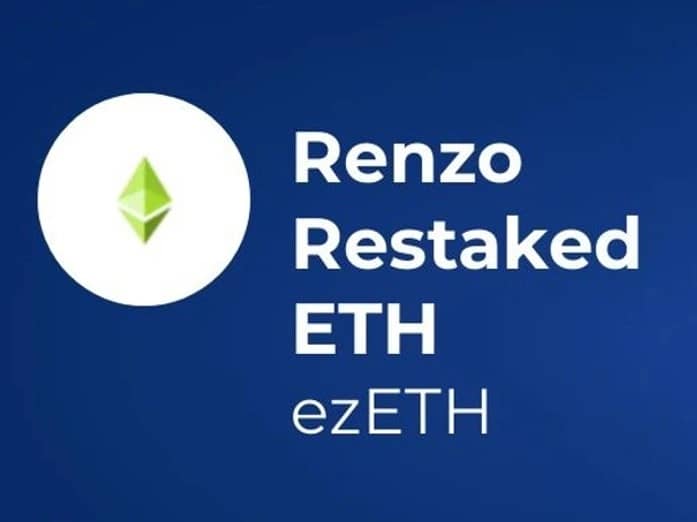Subscribe to wiki
Share wiki
Bookmark
Renzo Restaked ETH (ezETH)
The Agent Tokenization Platform (ATP):Build autonomous agents with the Agent Development Kit (ADK)
Renzo Restaked ETH (ezETH)
Renzo Restaked ETH (EZETH) functions as the Liquid Restaking Token (LRT) within the Renzo Protocol, symbolizing the user's restaked position. Participants can stake native ETH or liquid staking tokens (LSTs), like wBETH and stETH, and in return, acquire ezETH. ezETH is a reward-bearing token, implying that its value has the potential to surpass that of the underlying tokens due to its yield enhancement within Actively Validated Services (AVSs). [1] [2]
Overview
ezETH functions as a reward-bearing token akin to cTokens. The rewards are generated from the underlying restaking positions and are reflected in the value of ezETH. These rewards are anticipated to be ETH, USDC, and Actively Validated Services (AVSs) reward tokens. Consequently, ezETH's value is expected to appreciate relative to the underlying Liquid Staking Tokens (LSTs) as it accumulates more rewards in AVS tokens.
Renzo Protocol serves as an interface and strategy manager for EigenLayer. It uses a combination of operator nodes and smart contracts to optimize restaking strategies for users, aiming for the best risk/reward ratio across various AVSs. Renzo has delegated a high percentage of its Total Value Locked (TVL) across a curated list of AVSs, which contributes to its reward structure.
As of June 2025, Renzo Protocol has a TVL of over $976 million. The TVL is primarily composed of Ethereum ($919 million) and Solana ($57 million) restaked assets. ezETH specifically has a TVL of $851 million and an APY of 3.05%. ezETH secures several AVSs, including EigenDA, eoracle, Witness Chain, OpenLayer, and Cyber via AltLayer.
ezETH is available on multiple chains beyond Ethereum mainnet, including Linea, Unichain, Arbitrum One, Blast, Base, Mode, and BNB Smart Chain. The increasing number of blockchains and Layer 2 networks contributes to liquidity fragmentation, making cross-chain solutions like ezETH valuable. [1] [2] [3] [4] [5] [6]
ezETH Depeg
Renzo Protocol’s restaked Ether token (ezETH) experienced a price depeg on April 24th, 2024. The token's price briefly dropped to $688 on Uniswap decentralized exchange before recovering its price parity with Ether (ETH). The incident was likely triggered by a broader sell-off following the conclusion of Renzo Protocol’s season 1 airdrop, as users sought to convert ezETH back to ETH to farm other protocols.
According to analysts, similar depegging incidents are a risk for all LRTs. The depeg led to mass liquidations on leveraged protocols like Gearbox and Morpho Labs, with loopers (users using LRTs as collateral to borrow ETH) suffering significant losses. One trader reportedly profited nearly $400,000 in two hours by buying ezETH during the depeg and selling after it recovered. [7] [6] [8]
Rewards and Fees
ezETH is a reward-bearing token where staking and restaking rewards are auto-compounded. This auto-compounding mechanism means the value of ezETH increases relative to the underlying assets as it earns more rewards.
Renzo passes 100% of any EigenLayer rewards to users. Renzo charges a 10% fee on the rewards generated via restaking. This fee is split equally (50/50) between the protocol reserves (treasury) and Renzo node operators [1]
ezPoints
Renzo’s points system, known as ezPoints, is designed to incentivize and reward users for their active participation and contributions to the protocol's growth. Holding ezETH is a primary way to earn ezPoints, with users receiving 1 Renzo ezPoint per hour for every 1 ezETH held. Early participation and holding larger amounts of ezETH can also lead to earning additional points through various boosts. ezPoints play a crucial role in determining the allocation of REZ tokens a user receives during airdrop events. [2]
Team
The founding contributors of Renzo Protocol include Lucas Kozinski, James Coole, and Kratik Lodha. Lucas Kozinski has a background in the crypto industry, having worked at Moonwell, TokenSoft, and the Tezos Foundation. James Coole is a co-founder of TokenSoft, where he served as CTO. Kratik Lodha has experience in analytical roles at various funds. [2]
Investors
Renzo Protocol is backed by several prominent investors in the blockchain space. In January 2024, the protocol announced a $3.2 million seed funding round led by Maven11. Other participants in this round included IOSG Ventures, Figment Capital, and SevenX Ventures. Additional investors listed by Renzo include Binance Labs, OKX Ventures, Mantle, Edessa Capital, BODHI Ventures, Robot Ventures, and Re7Capital. [3] [2]
DeFi Integrations
Renzo Protocol's ezETH is integrated across various Decentralized Finance (DeFi) platforms, allowing users to earn additional yield on their restaked positions. Notable integrations include Aave, Spark, and Kamino. Renzo has also integrated with Pendle Finance, enabling the tokenization of ezETH into principal and yield tokens. [2] [3]
See something wrong?
The Agent Tokenization Platform (ATP):Build autonomous agents with the Agent Development Kit (ADK)
